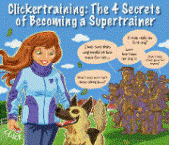Good Dog Training Advice
Get Fast & Simple Dog Training Tips to
Turn a Difficult Dog Into an Obedient Pet!
How to Prevent Dog Aggression with Other Dogs
There is something very disappointing when you find out your dog is incapable of spending time with other dogs
due to a habit of aggression.
This aggression should never be permitted and even if you generally keep your dog away from others, should be
stamped out quickly if possible.
The real threat, when a dog has aggression problems with other dogs, is that the aggression will grow and become a bigger threat in the future.
It might result in attacking behaviour that can put your dog at risk of being taken away and you being held
legally responsible.
So, far and beyond any other problem behaviours dog-to-dog aggression must be dealt with immediately.
Preventative Measures
To start with, keep your dog away from other dogs when possible. Use a muzzle and don't take your dog to parks or down busy streets until you can deal with their problems. If you have a puppy, make sure you socialize them early. Socialization can teach a dog how to respect and handle other dogs, without any potentially dangerous issues popping up. Generally speaking, if a puppy is aggressive towards other puppies, its playmates will correct that behaviour quickly. However, if there are no playmates to correct it, the habit can grow and become a problem when they mature. This makes dog training difficult later on in life.
Stopping Aggression Later in Life
Once a dog is older and shows signs of aggression towards other dogs, you'll need to take more direct measures to stop the behaviour. Many times, aggression is caused by a trigger such as territory, food, or a bed. If you can identify the trigger, training becomes much easier.
You also need to ensure you have asserted dominance over your own household. Sometimes, an aggressive dog is
merely trying to assert itself over others. By taking on a strong pack leader position, you can reduce the
opportunities for your dog to do this.
If your dog has not yet been spayed or neutered, this is an option you may consider, as it can often reduce aggression many times over. Additionally, you may want to visit your vet and make sure it is not a health related issue causing the aggression.
Watching for Warning Signs
Eventually, as you train your dog and assert your alpha leadership position, you'll need to take your dog into public again. However, you should remain wary of the potential for aggressive behaviour.
Direct eye contact, posturing, raised hair, stiffened tail, teeth exposure, or lunging are all signs that a
fight might occur if left out of hand and a good reason to back away from the other dog. Generally speaking, it
is a good idea to avoid other dogs until such behaviour can be controlled.
If you are trying to avoid aggression between two specific dogs, you should walk them together and let them get to know each other, avoiding any potential fighting between them. Many times, once you've shown your dog that you're in charge of the space in you walk and allowed them to acclimate in a controlled environment, they will behave much better when left alone in the future. Finally, if this kind of behaviour continues, you need to see a professional. The danger that is present in dog aggression can be too much for some people to handle. If the aggression ever elevates to violence, you should move beyond my advice and get hands on help or possibly even medication. | |
|


Discover the Secrets to Training Your Dog Or Puppy. Huge BONUSES for a limited time only!
Click here now...
|
http://GoodDogTrainingAdvice.com






